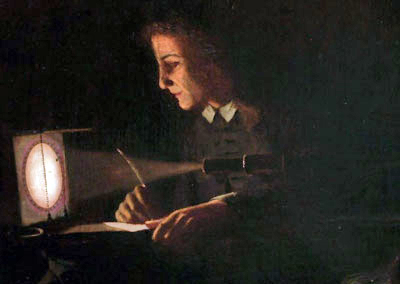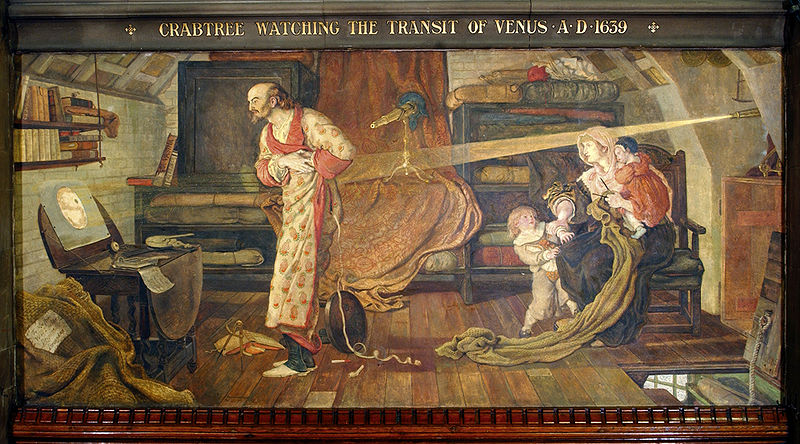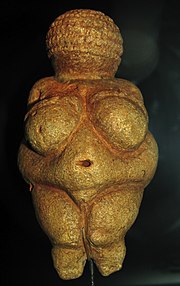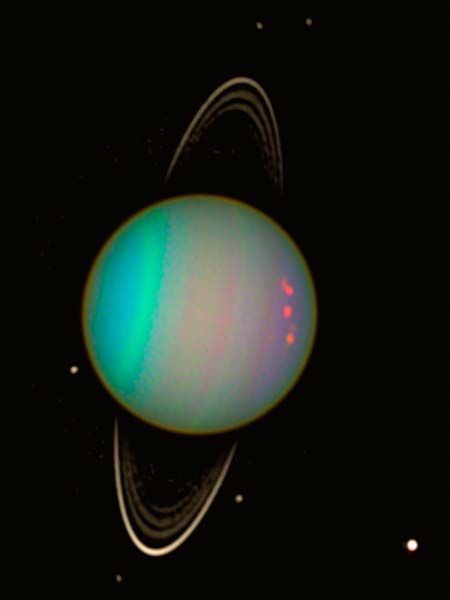http://en.wikipedia.org/wiki/Transit_of_Venus wrote:
-----------------------------------
December: 1631 and 1639
<<In 1627, Johannes Kepler became the first person to predict a transit of Venus, by predicting the 1631 event. His methods were not sufficiently accurate to predict that the transit would not be visible in most of Europe, and as a consequence, nobody was able to make arrangements to observe the phenomenon.
The first known observation of a transit of Venus was made by Jeremiah Horrocks from his home at Carr House in Much Hoole, near Preston in England, on 4 December 1639 (24 November under the Julian calendar then in use in England). His friend, William Crabtree, also observed this transit from Broughton, near Manchester. Kepler had predicted transits in 1631 and 1761 and a near miss in 1639. Horrocks corrected Kepler's calculation for the orbit of Venus, realized that transits of Venus would occur in pairs 8 years apart, and so predicted the transit in 1639. Although he was uncertain of the exact time, he calculated that the transit was to begin at approximately 3:00 pm. Horrocks focused the image of the Sun through a simple telescope onto a piece of paper, where the image could be safely observed. After observing for most of the day, he was lucky to see the transit as clouds obscuring the Sun cleared at about 3:15 pm, just half an hour before sunset. Horrocks' observations allowed him to make a well-informed guess as to the size of Venus, as well as to make an estimate of the distance between the Earth and the Sun.
He estimated that distance to be 59.4 million miles (95.6 Gm, 0.639 AU) – about two thirds of the actual distance of 93 million miles (149.6 million km) but a more accurate figure than any suggested up to that time. The observations were not published until 1661, well after Horrock's death.>>
-----------------------------------
June: 1761 and 1769
<<In 1663 Scottish mathematician James Gregory had suggested in his Optica Promota that observations of a transit of the planet Mercury, at widely spaced points on the surface of the Earth, could be used to calculate the solar parallax and hence the astronomical unit. Aware of this, a young Edmund Halley made observations of such a transit in 1676 from St Helena, but was disappointed to find that there had been only one other observation of the event and was not satisfied that the resulting calculation of the solar parallax at 45" was accurate. In 1678 he proposed that more accurate calculations could be made using measurements of a transit of Venus, although the next such event was not due until 1761. Halley died in 1742, but in 1761 numerous expeditions were made to various parts of the world so that precise observations of the transit could be made in order to make the calculations as described by Halley — an early example of international scientific collaboration. In an attempt to observe the first transit of the pair, scientists and explorers from Britain, Austria and France travelled to destinations around the world, including Siberia, Norway, Newfoundland and Madagascar. Most managed to observe at least part of the transit, but successful observations were made in particular by Jeremiah Dixon and Charles Mason at the Cape of Good Hope.
The unfortunate Guillaume Le Gentil spent eight years travelling in an attempt to observe either of the transits. His unsuccessful journey led to him losing his wife and possessions and being declared dead (his efforts became the basis of the play Transit of Venus by Maureen Hunter).
On the basis of his observation of the transit of Venus of 1761 from the Petersburg Observatory, Mikhail Lomonosov predicted the existence of an atmosphere on Venus. Lomonosov detected the refraction of solar rays while observing the transit and inferred that only refraction through an atmosphere could explain the appearance of a light ring around the part of Venus that had not yet come into contact with the Sun's disk during the initial phase of transit.
For the 1769 transit, scientists traveled to Hudson Bay (Canada), San José del Cabo (Baja California, then under Spanish control), and Norway. Observations were also made from Tahiti on the first voyage of Captain Cook, at a location still known as "Point Venus". The Czech astronomer Christian Mayer was invited by Catherine the Great to observe the transit in Saint Petersburg with Anders Johan Lexell, while other members of Russian Academy of Sciences went to eight other locations in the Russian Empire. In Philadelphia, the American Philosophical Society erected three temporary observatories and appointed a committee, of which David Rittenhouse was the head. The results of these observations were printed in the first volume of the Society's Transactions, published in 1771.
In 1771, using the combined 1761 and 1769 transit data, the French astronomer Jérôme Lalande calculated the astronomical unit to have a value of 153 million kilometers (±1 million km). The precision was less than hoped-for because of the black drop effect, but still a considerable improvement on Horrocks' calculations.
--------------------------------------------
December: 1874 and 1882
<<Unfortunately, it was impossible to time the exact moment of the start and end of the transit because of the phenomenon known as the "black drop effect". This effect was long thought to be due to Venus' thick atmosphere, and initially it was held to be the first real evidence that Venus had an atmosphere. However, recent studies demonstrate that it is an optical effect caused by the smearing of the image of Venus by turbulence in the Earth's atmosphere or imperfections in the viewing apparatus.
Transit observations in 1874 and 1882 allowed this value to be refined further. Several expeditions were sent to the Kerguelen Archipelago for the 1874 observations.
The American astronomer Simon Newcomb combined the data from the last four transits, and he arrived at a value of about 149.59 million kilometers (±0.31 million kilometers). Modern techniques, such as the use of radio telemetry from space probes, and of radar measurements of the distances to planets and asteroids in the Solar System, have allowed a reasonably accurate value for the astronomical unit (AU) to be calculated to a precision of about ±30 meters. Hence the need for parallax calculations has been superseded.>>
--------------------------------------------
 Contemplating the Sun
Contemplating the Sun




